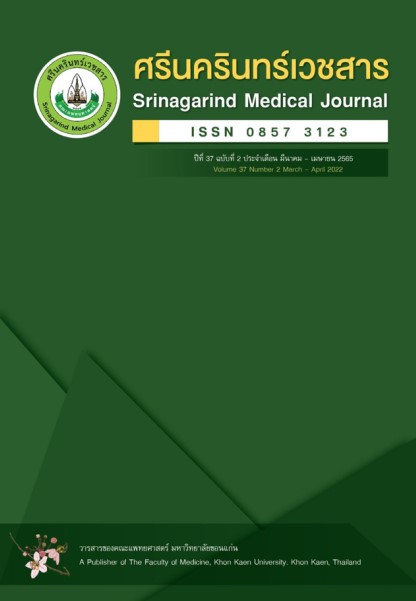ลักษณะภาพวินิจฉัยจากเครื่องเอกซเรย์คอมพิวเตอร์ของผู้ป่วยโรคหลอดเลือดดำในสมองอุดตันที่โรงพยาบาลสมเด็จพระยุพราชท่าบ่อ
Abstract
Computed Tomography Findings of Cerebral Venous Thrombosis at Thabo Crown Prince Hospital
บทคัดย่อ
หลักการและวัตถุประสงค์: ภาวะหลอดเลือดดำในสมองอุดตันเป็นภาวะที่วินิจฉัยได้ยากและท้าทายเนื่องจากผู้ป่วยสามารถมีอาการแสดงได้หลากหลายและไม่จำเพาะเจาะจง หากไม่ได้รับการวินิจฉัยและรักษาให้ทันท่วงทีอาจเกิดภาวะแทรกซ้อนรุนแรงถึงชีวิตได้ วัตถุประสงค์ของการศึกษานี้เพื่อรวบรวมลักษณะแสดงทางรังสีวิทยาจากการตรวจวินิจฉัยด้วยเครื่องเอกซเรย์คอมพิวเตอร์ของผู้ป่วยโรคหลอดเลือดดำในสมองอุดตัน
วิธีการศึกษา: การวิจัยเชิงพรรณนาย้อนหลังโดยการเก็บรวบรวมข้อมูลในผู้ป่วยโรคหลอดเลือดดำในสมองอุดตันทุกรายที่ได้รับการตรวจด้วยเครื่องเอกซเรย์คอมพิวเตอร์ระหว่างวันที่ 31 ตุลาคม พ.ศ. 2562 ถึงวันที่ 31 ตุลาคม พ.ศ. 2564 ที่โรงพยาบาลสมเด็จพระยุพราชท่าบ่อ
ผลการศึกษา: ผู้ป่วยโรคหลอดเลือดดำในสมองอุดตันจำนวน 18 ราย อายุระหว่าง 14-61 ปี อายุเฉลี่ยคือ 39.83±12.31 ปี พบลักษณะรอยโรคจำเพาะจากภาพเอกซเรย์คอมพิวเตอร์โดยไม่ฉีดสารทึบรังสี คือเส้นเลือดดำสมองขาวขึ้นจำนวน 16 ราย (ร้อยละ 88.9) พบลิ่มเลือดในเส้นเลือดดำจากภาพเอกซเรย์คอมพิวเตอร์ร่วมกับฉีดสารทึบรังสีจำนวน 16 ราย (ร้อยละ 100) ไม่พบความผิดปกติของเนื้อสมองจำนวน 8 ราย (ร้อยละ 44.4) พบภาวะแทรกซ้อนในเนื้อสมองเป็น เลือดออกในเนื้อสมอง 7 ราย (ร้อยละ 38.9) สมองขาดเลือด 5 ราย (ร้อยละ 27.8) ภาวะสมองบวม 3 ราย (ร้อยละ 16.7) และเลือดออกในช่องเยื่อหุ้มสมอง 3 ราย (ร้อยละ 16.7) ตำแหน่งเส้นเลือดดำใหญ่ที่พบว่ามีการอุดตันมากที่สุดคือ เส้นเลือดดำซุพีเรียร์ซาจิตตัล ร้อยละ 72.2 เส้นเลือดดำทรานสเวิร์สด้านขวาร้อยละ 55.6 เส้นเลือดดำทรานสเวิร์สด้านซ้าย เส้นเลือดดำซิกมอยด์ด้านขวา และเส้นเลือดดำในบริเวณเนื้อสมองชั้นนอก ตำแหน่งละ ร้อยละ 33.3 ตามลำดับ ความไวของการตรวจพบภาวะหลอดเลือดดำในสมองอุดตันด้วยเอกซเรย์คอมพิวเตอร์โดยไม่ฉีดและฉีดสารทึบรังสีอยู่ที่ ร้อยละ 88.9 และ 100 ตามลำดับ
สรุป: การตรวจด้วยเครื่องเอกซเรย์คอมพิวเตอร์เป็นสิ่งสำคัญในการวินิจฉัยภาวะหลอดเลือดดำในสมองอุดตัน
คำสำคัญ: โรคหลอดเลือดดำสมองอุดตัน, การตรวจเอกซเรย์คอมพิวเตอร์, ปวดศีรษะ, เลือดออกในเนื้อสมอง
ABSTRACT
Background and objective: Cerebral venous sinus thrombosis is a challenging condition because of the variability of its clinical symptoms and signs. Without immediate intervention, severe complications may cause death. The aim of this study was to determine the radiographic findings detected by computed tomography (CT) in cerebral venous thrombosis.
Methods: A retrospective descriptive study was conducted on all patients who had CT imaging performed for cerebral venous thrombosis detection between October 31, 2019, and October 31, 2021, at Thabo Crown Prince Hospital.
Results: A total of 18 patients with cerebral venous thrombosis were included in the study. Age of the patients ranged between 14–61 years with mean age was 39.83 ± 12.31 years. The pathognomonic signs were dense clot in non-contrast CT scan in 16 cases (88.9%), and empty delta sign in contrast-enhanced CT scan in 16 cases (100%). Parenchymal findings were no significant abnormalities in 8 cases (44.4%), intracerebral hemorrhage in 7 cases (38.9%), venous infarction in 5 cases (27.8%), cortical edema in 3 cases (16.7%), and subarachnoid hemorrhage in 3 cases (16.7%). The most common locations of thrombosis were the superior sagittal sinus 72.2%, right transverse sinus 55.6%, left transverse sinus, right sigmoid sinus, and cortical vein 33.3%, respectively. Sensitivity of non-contrast CT to identified cerebral venous thrombosis was 88.9%, and sensitivity of contrast-enhanced CT was 100%.
Conclusion: Computed tomography is essential in the diagnosis of cerebral vein thrombosis.
Keywords: Cerebral venous thrombosis, CT scan, headache, intracerebral hemorrhage


